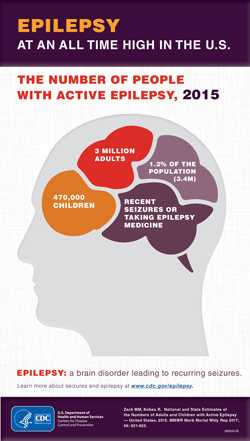5 Things You Should Know About Epilepsy

How much do you know about epilepsy? Get the facts!
Epilepsy is a brain disorder that causes repeated seizures. There are many different types of epilepsy and many different kinds of seizures. Epilepsy can get in the way of life, mostly when seizures keep happening. To control their seizures, people with epilepsy may take medicine, have surgery, or follow a special diet. Here’s what you need to know:

Epilepsy is common–about 3.4 million people in the U.S.
#1 Epilepsy is common.
In fact, you probably know a few people with epilepsy. A new CDC study has found that the number of people with active epilepsy (which means the person with epilepsy is under treatment or has had recent seizures) has increased compared to findings from 2007 and 2010. In 2015, about 3 million adults (age 18 and older) and 470,000 children (age 17 years or younger) had active epilepsy in the United States—that’s 3.4 million people.1 Think of a football stadium that seats 80,000 – that means about 900 people could have epilepsy.
#2 Seizures might look different than you expect.
What comes to mind when you think of a seizure? In the movies and on TV, they often show a person falling to the ground, shaking, and becoming unaware of what’s going on around them. That’s one kind of seizure, but it’s not the most common. More often, a person having a seizure may seem confused, stare into space, wander, make unusual movements, or can’t answer questions or talk. Sometimes it is hard to tell when a person is having a seizure, so it’s important to learn how to recognize different types of seizures.
#3 Seizure first aid is easy to give.
About 1 out of 10 people has had a seizure.2 That means seizures are common, and one day you might need to help someone. First aid for seizures involves keeping the person safe until the seizure stops on its own and knowing when to call 911 for emergency assistance.
It’s also important that professionals such as school nurses and other school staff, law enforcement, first responders, and childcare workers understand epilepsy and how to offer first aid. CDC supports training programs for these groups through a partnership with the Epilepsy Foundation.
#4 People with epilepsy can lead full lives.
Most people with epilepsy can do the same things that people without epilepsy can do. There are many successful people with epilepsy who work in medicine, sports, entertainment, government, and other professions. People with uncontrolled seizures or severe types of epilepsy face more challenges and may find it difficult to work or go to school regularly. Many adults with epilepsy have a hard time finding jobs, transportation, and affording medical care. People with epilepsy, their friends, and family can learn more about managing epilepsy from CDC and our partners.
#5 Some causes of epilepsy are preventable.
Epilepsy can be caused by different conditions that affect a person’s brain. Many times the cause is unknown. Traumatic brain injuries (TBIs), stroke, certain infections (such as cysticercosis, which is the leading cause of epilepsy worldwide), and pregnancy complications are some preventable causes of epilepsy. Learn more about preventing epilepsy and reducing your risk.
To learn more about epilepsy: www.cdc.gov/epilepsy
References
- Zack MM, Kobau R. National and State Estimates of the Numbers of Adults and Children with Active Epilepsy — United States, 2015. MMWR Morb Mortal Wkly Rep 2017;66:821–825. DOI:http://dx.doi.org/10.15585/mmwr.mm6631a1.
- Hauser WA, et al. Descriptive epidemiology of epilepsy: Contributions of population-based studies from Rochester, Minnesota. Mayo Clinic Proceedings. 1996;71(6):576-86.
More Information
- Page last reviewed: August 17, 2017
- Page last updated: August 17, 2017
- Content source:
- National Center for Chronic Disease Prevention and Health Promotion, Division of Population Health
- Page maintained by: Office of the Associate Director for Communication, Digital Media Branch, Division of Public Affairs




 ShareCompartir
ShareCompartir